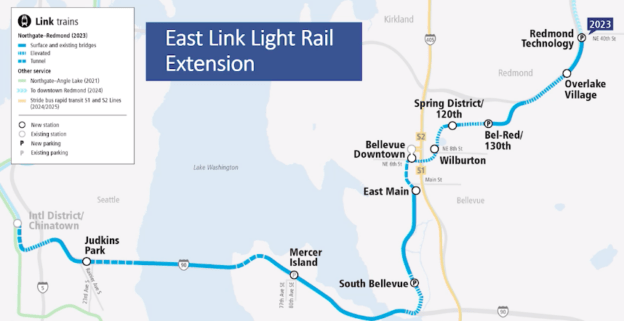The E360 (SR520 to Overlake Village Station) Project is one of six project segments that make up the 14-mile long East Link Light Rail Extension being built by Sound Transit. The East Link runs from Seattle through Mercer Island, and ends at Microsoft’s Redmond Technology Campus. East Link is part of a multi-billion dollar suit of light rail projects being built by Sound Transit through 2041 to better connect the Seattle Metropolitan Region.
The Contractor used innovative methods to manage stormwater over 50 acres within the congested 1.7 mile-long urban project corridor to prevent legacy soil contamination from impacting protected wetlands and receiving waters. Because of soils contaminated with lube oil-range petroleum hydrocarbons, cPAHs, and lead, the Washington State Department of Ecology issued an Administrative Order (AO) tied to the Construction Stormwater General Permit (CSWGP) issued for the project.
To meet the strict water quality requirements of the AO and the CSWGP, the Contractor elected to capture and treat all stormwater within the project corridor over the course of the 3-year long construction project. Throughout the corridor, the Contractor used existing catch basins or installed new temporary catch basins with float-switch-activated sump pumps to capture stormwater at strategic low points within each drainage sub-basin. Power at each collection point was supplied by diesel generators, and conveyance piping tied back to stormwater ponds built with Ecology blocks and heavy liners. At key points, discharge pipes to WSDOT’s drainage system and the MS4s operated by the Cities of Bellevue and Redmond were blocked with temporary plugs to prevent stormwater discharges. All captured stormwater was conveyed to the stormwater ponds or Baker tanks for initial settling, pond water elevations were monitored in real time using remote telemetry, and water was treated using chitosan enhanced sand filtration (CESF) with granular activated carbon (GAC) prior to testing and discharge. The overall system of stormwater capture and treatment was enhanced using adaptive management and various simple but effective BMPS such as tire baths and pressure washing truck tires in combination with rumble plates and street sweeping.
Through these innovative approaches to stormwater management and TESC, critical areas in and adjacent to this tightly constrained project corridor were protected from sediment and legacy contaminants.
About Instructors




